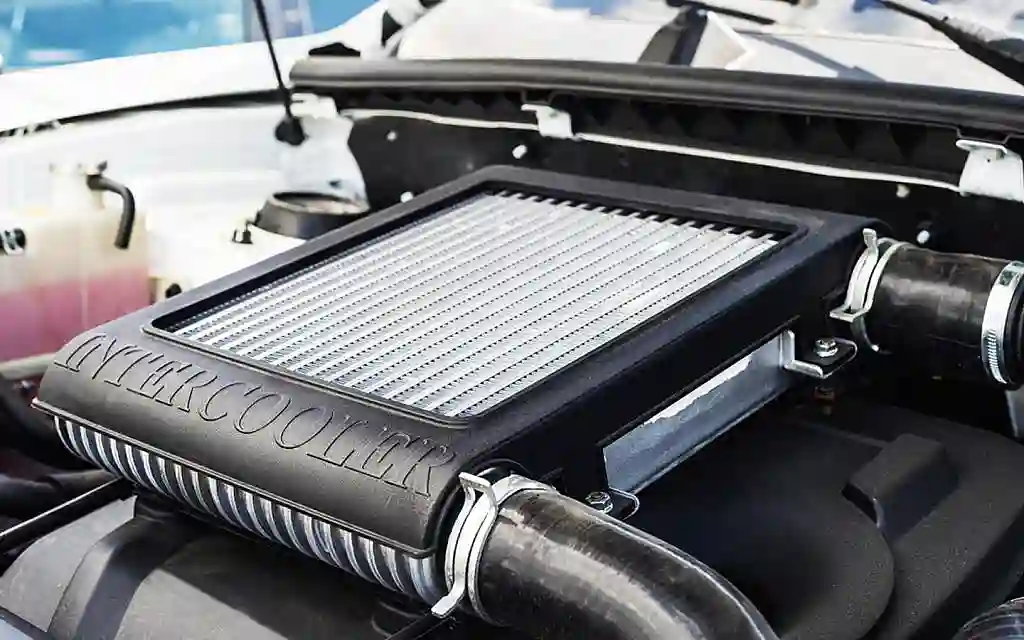Vehicle intercoolers are vital components in turbocharged and supercharged engines, designed to enhance performance and efficiency. They play a crucial role in cooling the intake air, which can lead to significant improvements in engine power and reliability. Understanding the function, types, and benefits of intercoolers is essential for optimizing engine performance and ensuring longevity. This article explores the key aspects of vehicle intercoolers, including their operation, types, and installation considerations, providing a comprehensive overview for anyone looking to enhance their vehicle’s performance.
Function and Benefits of Intercoolers
Intercoolers play a crucial role in enhancing engine performance by cooling the compressed air that enters the engine, which in turn improves combustion efficiency and power output. By reducing the temperature of the intake air, intercoolers help prevent engine knock and maintain optimal operating temperatures. When combined with an air intake kit such as an Audi cold air intake, which delivers cooler air to the engine, the overall performance benefits are even more pronounced. This synergy between the intercooler and a high-quality air intake system can lead to improved throttle response and increased horsepower. Properly maintaining these components ensures sustained performance improvements and engine longevity.
Air-to-Air Intercoolers
Air-to-air intercoolers are the most common type used in performance vehicles. These intercoolers use ambient air to cool the intake air, with the hot air from the turbocharger passing through the intercooler’s core while external air flows over the core to absorb heat. The efficiency of an air-to-air intercooler depends on factors such as the size of the core, the surface area, and the airflow through the intercooler. These intercoolers are generally easier to install and maintain, making them a popular choice for many performance applications. Proper placement and sizing are crucial to ensure that the intercooler effectively cools the intake air and supports engine performance.
Air-to-Water Intercoolers
Air-to-water intercoolers use water to cool the intake air, which an external heat exchanger then cools. This setup typically includes a water-to-air heat exchanger that transfers heat from the water to the ambient air. Air-to-water intercoolers are often used in applications where space is limited or where higher levels of cooling are required. They provide more consistent cooling and can be more effective in maintaining lower intake temperatures. However, they are more complex to install and maintain compared to air-to-air intercoolers, requiring additional components such as water pumps and heat exchangers.
Intercooler Sizing and Placement
The size and placement of an intercooler are critical factors that influence its effectiveness. An intercooler that is too small can not adequately cool the intake air, leading to reduced performance gains. Conversely, an excessively large intercooler can create additional drag and can not fit properly within the vehicle’s engine bay. Proper placement ensures optimal airflow through the intercooler, and positioning it in a location with sufficient air supply is essential for efficient cooling. Considerations such as vehicle design, intended use, and performance goals should guide the selection of intercooler size and placement.
Installation Considerations
Installing an intercooler involves several important considerations to ensure optimal performance and reliability. Proper mounting and alignment are essential to prevent vibration and ensure that the intercooler remains securely in place. The installation process can require modifications to the vehicle’s front bumper or grille to accommodate the intercooler’s size. Additionally, the routing of intake and outlet pipes must be carefully planned to minimize turbulence and pressure loss. Professional installation is recommended for complex setups to ensure that all components are correctly fitted and that the intercooler operates efficiently.
Performance Impact and Tuning
The installation of an intercooler can significantly impact engine performance, but other factors, such as engine tuning, can influence its effectiveness. After installing an intercooler, it is often necessary to adjust the engine’s ECU settings to account for the improved cooling and increased air density. Proper tuning ensures that the engine can take full advantage of the cooler intake air, optimizing fuel delivery and ignition timing for enhanced performance. Failure to adjust the engine tune can result in suboptimal performance gains and potential engine issues. Regular performance evaluations and tuning adjustments are recommended to maintain optimal performance and reliability.
Maintenance and Care
Regular maintenance and care are essential to ensure that an intercooler continues to perform effectively over time. Routine checks should include inspecting the intercooler for signs of damage, leaks, or blockages that could impair cooling efficiency. Cleaning the intercooler periodically helps remove debris and buildup that can affect performance. Additionally, monitoring the associated piping and connections for leaks or wear is important to maintain proper airflow and prevent performance issues. Proper maintenance helps extend the lifespan of the intercooler and ensures consistent performance.
Troubleshooting Common Issues
Identifying and addressing common issues with intercoolers is crucial for maintaining optimal performance. Problems such as reduced cooling efficiency, excessive heat soak, or intercooler leaks can negatively impact engine performance. Heat soak occurs when the intercooler becomes heat-saturated, reducing its ability to cool the intake air effectively. Leaks in the intercooler or associated piping can lead to decreased performance and increased engine temperatures. Regular inspections and prompt repairs are necessary to address these issues and ensure the intercooler functions as intended.
Conclusion
Vehicle intercoolers are integral components for enhancing engine performance and efficiency, particularly in turbocharged and supercharged applications. Understanding their function, types, and installation considerations helps in making informed decisions about upgrading or maintaining an intercooler system. Proper sizing, placement, and maintenance are crucial for achieving optimal performance gains and ensuring the longevity of the intercooler. By addressing common issues and performing regular upkeep, vehicle owners can maximize the benefits of intercoolers and enhance their driving experience. Effective management of intercooler systems contributes to improved power output, better fuel efficiency, and overall engine reliability.

